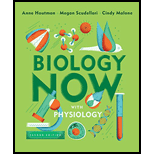
Concept explainers
A taxonomic tribal group those belonging to the subfamily Homininae are known as Hominins. This group consists of the genus Homo though it does not include the genus Gorilla. An example of earliest hominins is Sahelanthropus tchadensis. An example of early hominins is Ardipithecus ramidus. It is an ape.
Answer to Problem 1TQ
Originally it was described that a single evolutionary line exists between Ardipithecus ramidus and modern humans through a series of evolutionary stages and not a single line. Later, Ardipithecus ramidus was discovered to be closely related to chimpanzees.
Therefore, option (a) is correct.
Explanation of Solution
Justify the reasons for the correct statement:
The brains (400 cubic centimeters) and the teeth of all hominins, including Ardipithecus ramidus were small as compared to humans. These features of human resembled with those features of Chimpanzees. The volume of the human brain is 1,400 cubic centimeters. The earliest known hominin dates 6 to 7 million years ago, others dates 4.4 million years ago, and several others dates 3 to 4.2 million years. Anatomically modern human appears to be evolved over 200, 000 years ago. All these suggests that the ape does not evolve into human.
Option (a) is given as, “A single evolutionary line led from Ardipithecus ramidus to modern humans”.
Hence, the option (a) is correct.
Justify the reasons for the incorrect statements:
Option (b) is given as, “Some hominid traits evolved more rapidly than others”.
The earliest known hominins, belonging to the Hominid family dated 6 to 7 million years ago, others dates 4.4 million years ago, and several others dates 3 to 4.2 million years. This data suggests that the hominid traits evolved more rapidly as compared to others. This statement is true. Hence, it is a wrong answer.
Option (c) is given as, “Brain size increased greatly from early hominids to Homo sapiens”.
The brains of early hominids measured 400 cubic centimeters that increased greatly to 1,400 cubic centimeters in humans. This statement is true. Hence, it is a wrong answer.
Option (d) is given as, “Tool making technology has improved greatly over the past 300, 000 years”.
Hominids were the first to use stone tools and the tool making technology has improved over several years or the past 300, 000 years resulting in iron tools. This statement is true. Hence, it is a wrong answer.
Hence, options (b), (c), and (d) are incorrect.
Human beings are not just closely related to apes. They are a part of separate branch termed hominins. Hence, the given statement ‘a single evolutionary line led from Ardipithecus ramidus to modern humans’ is not true.
Want to see more full solutions like this?
Chapter 17 Solutions
Biology Now with Physiology (Second Edition)
- What is the structure and function of Eukaryotic cells, including their organelles? How are Eukaryotic cells different than Prokaryotic cells, in terms of evolution which form of the cell might have came first? How do Eukaryotic cells become malignant (cancerous)?arrow_forwardWhat are the roles of DNA and proteins inside of the cell? What are the building blocks or molecular components of the DNA and proteins? How are proteins produced within the cell? What connection is there between DNA, proteins, and the cell cycle? What is the relationship between DNA, proteins, and Cancer?arrow_forwardWhy cells go through various types of cell division and how eukaryotic cells control cell growth through the cell cycle control system?arrow_forward
- In one paragraph show how atoms and they're structure are related to the structure of dna and proteins. Talk about what atoms are. what they're made of, why chemical bonding is important to DNA?arrow_forwardWhat are the structure and properties of atoms and chemical bonds (especially how they relate to DNA and proteins).arrow_forwardThe Sentinel Cell: Nature’s Answer to Cancer?arrow_forward
- Molecular Biology Question You are working to characterize a novel protein in mice. Analysis shows that high levels of the primary transcript that codes for this protein are found in tissue from the brain, muscle, liver, and pancreas. However, an antibody that recognizes the C-terminal portion of the protein indicates that the protein is present in brain, muscle, and liver, but not in the pancreas. What is the most likely explanation for this result?arrow_forwardMolecular Biology Explain/discuss how “slow stop” and “quick/fast stop” mutants wereused to identify different protein involved in DNA replication in E. coli.arrow_forwardMolecular Biology Question A gene that codes for a protein was removed from a eukaryotic cell and inserted into a prokaryotic cell. Although the gene was successfully transcribed and translated, it produced a different protein than it produced in the eukaryotic cell. What is the most likely explanation?arrow_forward
 Human Anatomy & Physiology (11th Edition)BiologyISBN:9780134580999Author:Elaine N. Marieb, Katja N. HoehnPublisher:PEARSON
Human Anatomy & Physiology (11th Edition)BiologyISBN:9780134580999Author:Elaine N. Marieb, Katja N. HoehnPublisher:PEARSON Biology 2eBiologyISBN:9781947172517Author:Matthew Douglas, Jung Choi, Mary Ann ClarkPublisher:OpenStax
Biology 2eBiologyISBN:9781947172517Author:Matthew Douglas, Jung Choi, Mary Ann ClarkPublisher:OpenStax Anatomy & PhysiologyBiologyISBN:9781259398629Author:McKinley, Michael P., O'loughlin, Valerie Dean, Bidle, Theresa StouterPublisher:Mcgraw Hill Education,
Anatomy & PhysiologyBiologyISBN:9781259398629Author:McKinley, Michael P., O'loughlin, Valerie Dean, Bidle, Theresa StouterPublisher:Mcgraw Hill Education, Molecular Biology of the Cell (Sixth Edition)BiologyISBN:9780815344322Author:Bruce Alberts, Alexander D. Johnson, Julian Lewis, David Morgan, Martin Raff, Keith Roberts, Peter WalterPublisher:W. W. Norton & Company
Molecular Biology of the Cell (Sixth Edition)BiologyISBN:9780815344322Author:Bruce Alberts, Alexander D. Johnson, Julian Lewis, David Morgan, Martin Raff, Keith Roberts, Peter WalterPublisher:W. W. Norton & Company Laboratory Manual For Human Anatomy & PhysiologyBiologyISBN:9781260159363Author:Martin, Terry R., Prentice-craver, CynthiaPublisher:McGraw-Hill Publishing Co.
Laboratory Manual For Human Anatomy & PhysiologyBiologyISBN:9781260159363Author:Martin, Terry R., Prentice-craver, CynthiaPublisher:McGraw-Hill Publishing Co. Inquiry Into Life (16th Edition)BiologyISBN:9781260231700Author:Sylvia S. Mader, Michael WindelspechtPublisher:McGraw Hill Education
Inquiry Into Life (16th Edition)BiologyISBN:9781260231700Author:Sylvia S. Mader, Michael WindelspechtPublisher:McGraw Hill Education





